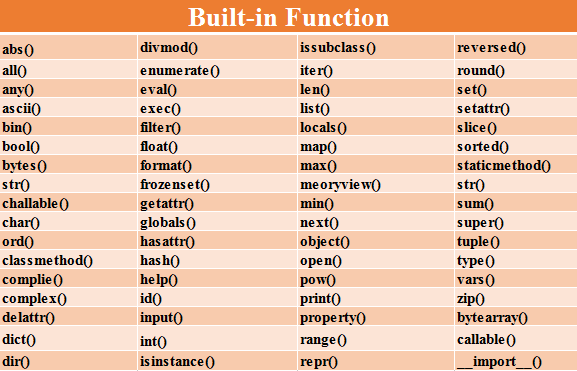
将68个内置函数按照其功能分为了10类,分别是:
- 数学运算(7个)
- abs() divmod() max() min() pow() round() sum()
- 类型转换(24个)
- bool() int() float() complex() str() bytearray()
- bytes() memoryview() ord() chr() bin() oct() hex()
- tuple() list() dict() set() frozenset( ) enumerate()
- range() iter() slice() supper() object()
- 序列操作(8个)
- all() any() filter() map() next() reversed() sorted() zip()
- 对象操作(7个)
- help() dir() id() hash() type() len() ascii() format() vars()
- 反射操作(8个)
- _import__() isinstance() issubclass() hasattr() getattr() setattr() delattr() callable()
- 变量操作(2个)
- globals() locals()
- 交互操作(2个)
- print() input()
- 文件操作(1个)
- open()
- 编译执行(4个)
- compile() eval() exec() repr()
- 装饰器(3个)
- property() classmethod() staticmethod()
一、数学运算类(7个)
abs()
Return the absolute value of the argument.取绝对值
print(abs(-1)) #执行结果 1
divmod()
divmod(x, y) -> Return the tuple (x//y, x%y).返回商和余数
print(divmod(5, 2)) #执行结果 (2, 1)
max()
返回最大值
处理的对象为可迭代对象
(相当于一个for循环取出每一个元素进行比较)
不同类型之间是不能进行比较的
每个元素进行比较时,是从每个元素的第一个位置开始依次比较
(如果一个位置分出大小,后面的位置可以不用进行比较便可以得出比较结果)
#用法一: num_1 = [1,38,2,0,4,7] print(max(num_1))
#用法二:传入对象为字典,默认比较的是字典的key age_dic={'age1':14, 'age2':3, 'age3':45, 'age1':18} print(max(age_dic)) print(max(age_dic.values())) # 比较的是字典的values #执行结果 age4 45
用法三:
任务:
将给定名单中年龄最大的找出来
people_list = [
{'name':'xhg','age':18},
{'name':'aaa','age':10},
{'name':'bbb','age':30},
{'name':'ccc','age':14},
]
print(max(people_list, key = lambda dic:dic['age']))
#执行结果
{'name': 'bbb', 'age': 30}
'''
#程序分析
#这段代码的理解 max(people_list, key = lambda dic:dic['age'],实际上进行了这样一个操作
ret = []
for item in people_list:
ret.append(item['age'])
print(max(ret))
'''
min()
- 返回可迭代对象的元素中的最小值或者所有参数的最小值
- 具体用法同max()函数
pow()
Equivalent to x**y (with two arguments) or x**y % z (with three arguments)
两个参数,做幂运算
三个参数,先做幂运算,再取余
print(pow(2,3)) #执行结果 8 print(pow(2,3,3)) #执行结果 2
round()
对浮点数进行四舍五入求值
第二个参数为可选参数,如果不填默认取整,参数代表保留的位数
print(round(3.1415926)) print(round(3.1415926, 3)) #执行结果 3 3.142
sum()
对可迭代对象中的每个元素求和
可迭代对象中的元素类型是数值
print(sum([1, 2, 3, 4, 5])) #执行结果 15
二、类型转换(24个)
bool()
根据传入的参数的逻辑值创建一个新的布尔值
None '' () {} [] 0 ==>False
其余 ==>True
print(bool(None)) print(bool('xhg')) #执行结果 False True
int()
根据传入的参数创建一个整数
print(int('123')) #将字符串转化为整形 print(int(123.9)) #取整
#执行结果 123 123
float()
根据传入的参数创建一个新的浮点数
print(float('123.78')) #将字符串转化为浮点型
print(float(123)) #将整形转换成浮点型
#执行结果
123.78
123.0
complex()
根据传入参数创建一个新的复数
有两个参数:
第一个参数是实部;第二个参数是虚部
不填参数,默认输出为 0j
只填一个参数 a,则输出 a + 0j
print(complex()) print(complex(1)) print(complex(1, 2))
#执行结果 0j (1+0j) (1+2j)
str()
将目标参数转化为字符串
print(str(123)) print(type(str(123))) print(str([1, 2, 3, 4, 'xhg'])) print(type(str([1, 2, 3, 4, 'xhg'])))
#执行结果 123 <class 'str'> [1, 2, 3, 4, 'xhg'] <class 'str'>
bytearray()
根据传入的参数创建一个新的字节数组
可传入的参数:
- 字符串(使用指定编码方式编码);bytearray()然后使用str.encode()将字符串转换为字节。
- 如果它是一个整数,那么数组将具有这个大小,并将用null字节初始化。
- 如果它是符合缓冲区接口的对象,则将使用对象的只读缓冲区来初始化字节数组。
- 如果它是可迭代的,那么它必须是range 0 < = x < 256的整数的迭代,它被用作数组的初始内容
a = bytearray('小伙郭', encoding = 'utf -8' ) #字符串需要指定编码方式 print(a, len(a)) b = bytearray('小伙郭', encoding = 'gbk' ) print(b, len(b)) c = bytearray([1,2,3,255]) #如果元素大于255,将会报错 print(c, len(c))
#执行结果 bytearray(b'\xe5\xb0\x8f\xe4\xbc\x99\xe9\x83\xad') 9 bytearray(b'\xd0\xa1\xbb\xef\xb9\xf9') 6 bytearray(b'\x01\x02\x03\xff') 4
bytes()
- 根据传入的参数创建一个新的不可变字节数组
- 具体用法及传入的参数同函数bytearray()
ord()
chr()
返回Unicode字符对应的整数
返回整数所对应的Unicode字符
print(ord('d')) print(chr(100)) #执行结果 100 d
bin()整数-->2进制字符串
oct()整数-->8进制数字符串
hex()整数-->16进制字符串
print(bin(5))
print(oct(10))
print(hex(15))
#执行结果
0b101
0o12
0xf
tuple()
根据传入的参数创建一个新的元组
传入的参数为空或者是可迭代对象
print(tuple()) print(tuple('123456')) print(tuple([1, 2, 'a', 'b']))
#执行结果 () ('1', '2', '3', '4', '5', '6') (1, 2, 'a', 'b')
list()
根据传入的参数创建一个新的列表
传入的参数为空或者是可迭代对象
print(list()) print(list('123456')) print(list([1, 2, 'a', 'b']))
#执行结果 [] ['1', '2', '3', '4', '5', '6'] [1, 2, 'a', 'b']
dict()
根据传入的参数创建一个新的字典
可以由下列四种方式传入参数:
- 不传入参数,建立空字典
- 通过映射函数创建字典
- 通过键值对来创建字典
- 通过可迭代对象来创建字典
print(dict()) print(dict(zip(['key1', 'key2'],[1, 2]))) print(dict(key1 = 'a', key2 = 'b')) print(dict([['key1',1], ['key2','b']]))
#执行结果 {} {'key1': 1, 'key2': 2} {'key1': 'a', 'key2': 'b'} {'key1': 1, 'key2': 'b'}
set()
根据传入的参数创建一个新的集合
set() -> new empty set object
set(iterable) -> new set object
print(set()) print(set('123456')) print(set([1,2,3,'a','b']))
#执行结果 set() {'3', '1', '6', '2', '5', '4'} {1, 2, 3, 'b', 'a'}
frozenset()
根据传入的参数创建一个新的不可变集合
print(frozenset()) print(frozenset('123456'))
frozenset() frozenset({'5', '1', '4', '3', '6', '2'})
range()
根据传入的参数创建一个新的range对象
python3里面,需要通过for循环来创建range()每一个元素
range(a,b)-->左闭右开
range(stop) -> range object
range(start, stop[, step]) -> range object
for item in range(5): print(item) for item in range(10, 15): print(item) for item in range(0, 100, 20): print(item)
#执行结果 0 1 2 3 4 10 11 12 13 14 0 20 40 60 80
写在后面:
内置函数总结好多哦
今天眼睛看电脑时间太长了 累
明天继续总结吧
今天也就总结了一半的样子
最近发现之前的知识有些忘记了
需要返回去再看看了
开题报告写的不是很好 今天老师要求重新写
好好加油吧
明天就是周末啦 可以粗去吃好吃的 放松放松
更重要的 双11 买买买













